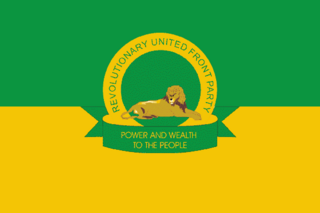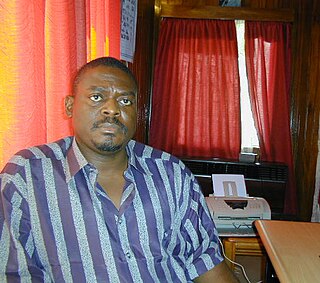Related Research Articles

Sierra Leone, officially the Republic of Sierra Leone, is a country on the southwest coast of West Africa. It is bordered to the southeast by Liberia and by Guinea to the north. Its land area is 71,740 km2 (27,699 sq mi). It has a tropical climate and environments ranging from savannas to rainforests. As of the 2023 census, Sierra Leone has a population of 8,908,040. Freetown is both its capital and its largest city. The country is divided into five administrative regions, which are further subdivided into 16 districts.
Sierra Leone first became inhabited by indigenous African peoples at least 2,500 years ago. The Limba were the first tribe known to inhabit Sierra Leone. The dense tropical rainforest partially isolated the region from other West African cultures, and it became a refuge for peoples escaping violence and jihads. Sierra Leone was named by Portuguese explorer Pedro de Sintra, who mapped the region in 1462. The Freetown estuary provided a good natural harbour for ships to shelter and replenish drinking water, and gained more international attention as coastal and trans-Atlantic trade supplanted trans-Saharan trade.

The Republic of Sierra Leone Armed Forces are the armed forces of Sierra Leone, responsible for the territorial security of Sierra Leone's borders and defending the national interests of Sierra Leone, within the framework of the 1991 Sierra Leone Constitution and International laws. The armed forces were formed after independence in 1961, on the basis of elements of the former British Royal West African Frontier Force, then present in the Sierra Leone Colony and Protectorate.

Brigade of Gurkhas is the collective name which refers to all the units in the British Army that are composed of Nepalese Gurkha soldiers. The brigade draws its heritage from Gurkha units that originally served in the British Indian Army prior to Indian independence, and prior to that served for the East India Company. The brigade includes infantry, engineering, signal, logistic and training and support units. They are known for their khukuri, a distinctive heavy knife with a curved blade, and have a reputation for being fierce and brave soldiers.

The Revolutionary United Front (RUF) was a rebel group that fought a failed eleven-year war in Sierra Leone, beginning in 1991 and ending in 2002. It later transformed into a political party, which still exists today. The three most senior surviving leaders, Issa Sesay, Morris Kallon, and Augustine Gbao, were convicted in February 2009 of war crimes and crimes against humanity.

Alhaji Ahmad Tejan Kabbah was a Sierra Leonean politician who served twice as the 3rd President of Sierra Leone, from 1996 to 1997 and again from 1998 to 2007. An economist and attorney by profession, Kabbah spent many years working for the United Nations Development Programme. He retired from the United Nations and returned to Sierra Leone in 1992.

Major Johnny Paul Koroma was a Sierra Leonean military officer who was the head of state of Sierra Leone from May 1997 to February 1998.

Operation Barras was a British Army operation that took place in Sierra Leone on 10 September 2000, during the late stages of the nation's civil war. The operation aimed to release five British soldiers of the Royal Irish Regiment and their Sierra Leone Army (SLA) liaison officer, who were being held by a militia group known as the "West Side Boys". The soldiers were part of a patrol that was returning from a visit to Jordanian peacekeepers attached to the United Nations Mission in Sierra Leone (UNAMSIL) at Masiaka on 25 August 2000 when they turned off the main road and down a track towards the village of Magbeni. There the patrol of twelve men was overwhelmed by a large number of heavily armed rebels, taken prisoner, and transported to Gberi Bana on the opposite side of Rokel Creek.
The Armed Forces Revolutionary Council (AFRC) was a group of Sierra Leone soldiers that allied itself with the rebel Revolutionary United Front in the late 1990s. While the AFRC briefly controlled the country in 1998, it was driven from the capital by an international military intervention of the Economic Community of West African States Monitoring Group (ECOMOG). It was no longer a coherent and effective organization by the elections of 2002.
The Sierra Leonean Civil War (1991–2002) was a civil war in Sierra Leone that began on 23 March 1991 when the Revolutionary United Front (RUF), with support from the special forces of Liberian dictator Charles Taylor's National Patriotic Front of Liberia (NPFL), intervened in Sierra Leone in an attempt to overthrow the Joseph Momoh government. The resulting civil war lasted almost 11 years, and had over 50,000, up to 70,000, casualties in total; an estimated 2.5 million people were displaced during the conflict, and widespread atrocities occurred.
Niggaz is an altered form of niggas, a plural form of the English vulgar word nigga, used in African-American vernacular English.
Brigadier John Amadu Bangura, CBE was a Sierra Leonean who served as Chief of the Defence Staff of the Sierra Leone Armed Forces from 1968 to 1971. Prior to this in 1967, he served as the Sierra Leonean Ambassador of to the United States.

Mass media in Sierra Leone began when the first modern printing press in Africa arrived at the start of the 19th century. In the 1860s the country became a journalist hub for Africa with professional travelling to the country from across the continent. At the end of the 19th century the industry went into decline and when radio was introduced in the 1930s this became the primary communication media. Print media is not widely read in Sierra Leone, especially outside Freetown, partially due to the low levels of literacy in the country. In 2008 there were 15 daily newspapers in addition to those published weekly. Among newspaper readership young people are likely to read newspapers weekly and older people daily. The majority of newspapers are privately run and are often critical of the government.

United Nations Security Council resolution 1270 was adopted unanimously on 22 October 1999. After recalling resolutions 1171 (1998), 1181 (1998), 1231 (1999) and 1260 (1999) on the situation in Sierra Leone and Resolution 1265 (1999) on the protection of civilians in armed conflict, resolution 1270 adopted by the Security Council established the United Nations Mission in Sierra Leone (UNAMSIL) to assist in the implementation of the Lomé Peace Accord.

Neall Ellis is a South African military aviator and mercenary. Raised in Bulawayo, he joined the South African Air Force after a brief stint in the Rhodesian Army. As a helicopter pilot he was awarded the Honoris Crux decoration in 1983, and later attained field rank. After retiring from the SAAF he contracted for various private military corporations, including Executive Outcomes and Sandline International. During the civil war in Sierra Leone, he and his Mi-24 crew held off Revolutionary United Front (RUF) forces almost single-handedly. He also provided fire support for British troops during Operation Barras.
The Small Boys Unit (SBU) was a group of children who were forcibly recruited by the Revolutionary United Front (RUF) as militants during the Sierra Leone Civil War. The war began in 1991, when the RUF desired to overthrow the government and gain control of the diamond mines, a major source of revenue for the country. In 1998, 25% of the soldiers fighting in the war were under 18, and of those, 50% were abducted and 28% were under the age of 12. The war ended with a ceasefire on 18 January 2002.
The United Kingdom began a military intervention in Sierra Leone on 7 May 2000 under the codename Operation Palliser. Although small numbers of British personnel had been deployed previously, Palliser was the first large-scale intervention by British forces in the Sierra Leone Civil War. In early May 2000, the Revolutionary United Front (RUF)—one of the main parties to the civil war—advanced on the country's capital, Freetown, prompting the British government to dispatch an "Operational Reconnaissance and Liaison Team" (ORLT) to prepare to evacuate foreign citizens. On 6 May, the RUF blocked the road connecting Freetown to the country's main airport, Lungi. The next day, British soldiers began to secure the airport and other areas essential to an evacuation. The majority of those who wished to leave were evacuated within the first two days of the operation, but many chose to stay following the arrival of British forces.
The Lungi Lol confrontation was a confrontation between British forces and the Revolutionary United Front (RUF) in Sierra Leone on 17 May 2000.

Bilateral relations between Canada and Sierra Leone were first established in 1961, when Sierra Leone gained its independence. Canada is represented in Sierra Leone through its High Commission in Accra, Ghana. Sierra Leone is represented in Canada through its embassy in Washington, D.C.

Children in the military are children who are associated with military organizations, such as state armed forces and non-state armed groups. Throughout history and in many cultures, children have been involved in military campaigns. For example, thousands of children participated on all sides of the First World War and the Second World War. Children may be trained and used for combat, assigned to support roles such as porters or messengers, or used for tactical advantage as human shields or for political advantage in propaganda.
References
- 1 2 Sherwell, Philip (3 September 2000). "Caught with their guard down". The Daily Telegraph . Retrieved 18 September 2015.
- ↑ Reno, William (February 2003), Political Networks in a Failing State The Roots and Future of Violent Conflict in Sierra Leone, Internationale Politik und Gesellschaft, International Politics and Society, archived from the original on 23 July 2008, retrieved 21 April 2008
- ↑ Fofana, Lansana "SIERRA LEONE: Rap Star’s T-shirt A Major Factor In Conflict", Inter Press Service, October, 1998, retrieved 20 May 2018.
- ↑ "Who are the West Side Boys?". BBC News. 31 August 2000. Retrieved 30 April 2010.
- ↑ Utas, Mats; Jörgel, Magnus (2008). "The West Side Boys: military navigation in the Sierra Leone civil war". Journal of Modern African Studies . 46 (3): 487–511. doi:10.1017/S0022278X08003388. S2CID 54963975.